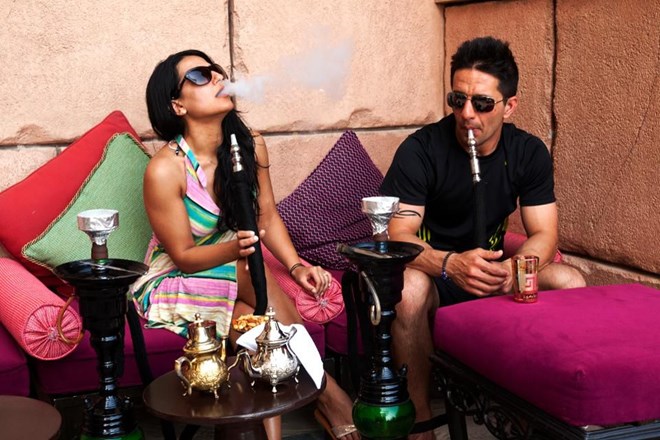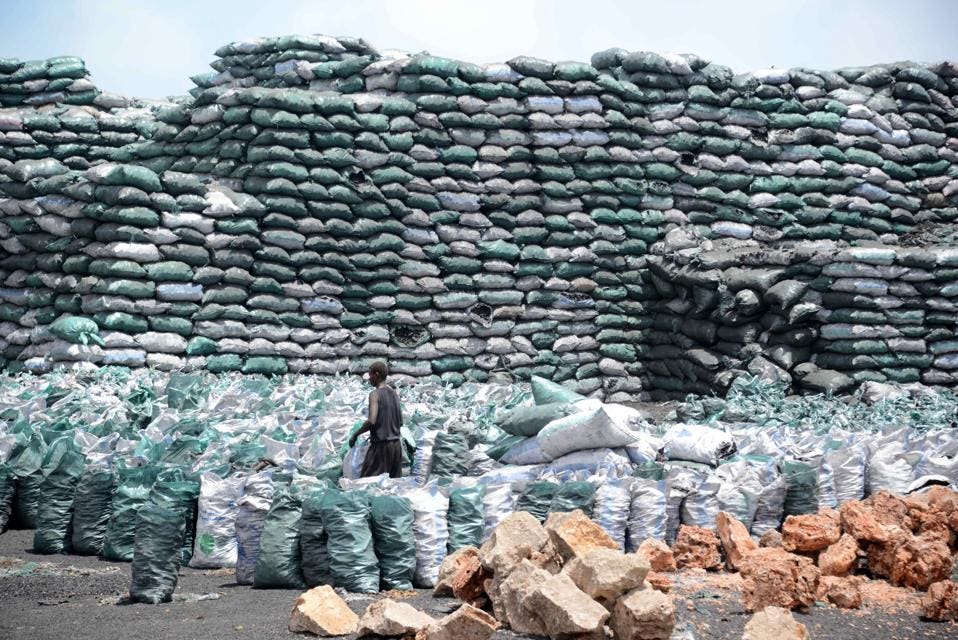
American tourists in Dubai, UAE smoke a hookah, on February 22, 2012. (Photo: ANDREW HOLBROOKE/Corbis via Getty Images) Getty
Someone relaxing in a Persian Gulf café by smoking a shisha pipe may not realise it, but the burning coals carefully placed on top of the hookah to heat the tobacco are not just fuelling their pleasure; they are also helping to fund a campaign of violence in one of the world’s poorest countries.
Globally, Al-Shabaab may not be as infamous as the likes of Islamic State, Al-Qaeda or the Taliban, but the Somali-based organisation is one of the four deadliest terrorist groups in the world.
The militant group first came to prominence in the summer of 2006, as an Al-Qaeda affiliate. Since then it has taken on an identity all of its own and been responsible for a campaign of deadly attacks in Somalia and in neighbouring countries such as Kenya, Ethiopia and Uganda. In 2017 it was responsible for the worst terrorist attack anywhere in the world, when a suicide bomber killed 587 people by detonating a truck laden with explosives outside a hotel in the Somali capital Mogadishu.
Behind its campaign of violence lies a sophisticated financing network based, in part, on trade in charcoal. According to the UN Monitoring Group on Somalia and Eritrea, the charcoal trade continues to be “a significant source of revenue” for Al-Shabaab, generating at least $7.5m from taxes at checkpoints in the Middle Juba and Lower Juba regions of Somalia where the charcoal is produced.
The charcoal in question comes from acacia trees and is prized in the Gulf because it burns for longer than charcoal from other sources. As well as helping to fill Al-Shabaab’s coffers, the trade risks environmental damage to Somalia, with millions of trees being felled to produce it.
Such is the demand that, according to estimates from the Somalia Water and Land Information Management project of the UN’s Food and Agriculture Organization, a tree was cut down to produce charcoal at a rate of one every 30 seconds between 2011 and 2017. An estimated 3.6 million bags of charcoal were produced in 2017, with Al-Shabaab thought to levy a tax of around $2.50 per bag as it is transported to the port towns of Buur Gaabo and Kismayo (where each bag fetches between $9 and $11).
Export volumes from those two ports vary between 300,000 and 600,000 bags a month, attracting a further tax of $5 a bag levied by the authorities there, which generates more than $15m in annual revenue for the Jubbaland administration.
Gulf counties are the key export market and, by the time the cargo reaches the ports there, the wholesale price of the bags has risen to around $50 each, meaning the total market value of Somali charcoal exports was around $150m a year in 2017.
Restricting the trade
The trade has been evolving though. Between November 2017 and February 2018 most exports went to Oman, where they were unloaded at Duqm and Shinas ports. But since March that year, Oman has been clamping down on the trade. That month it seized the Al Azhar 3 dhow and its cargo of 37,000 bags of charcoal, a move which forced the dhows which are used to transport the charcoal to find other ports.
In place of Oman, the dhows have been sailing on to the Kish and Qeshm free zones in Iran. A complex process has developed there, with false certificates of origin being used to claim the charcoal comes from the Comoros, Cote d’Ivoire, Gambia or Ghana. It is then repacked in the Iranian free zones into bags labelled ‘produce of Iran’, given a second set of false certificates of origin and then reexported on Iranian dhows to Hamriyah port in Dubai.
The UN Monitoring Group said in its report released last year that it had written to the authorities in both Iran and the UAE to discuss the trade, but found them uncooperative.
Nonetheless, there have clearly been some improvements in restricting the trade and the Monitoring Group estimates that charcoal exports from Somalia have recently declined from 4 million bags a year to 3 million bags. Compared to figures from other sources, the Monitoring Group's latest estimates suggest a clear decline in the value of the trade. As recently as 2014, some were estimating the value of the trade at $384m. Back then, a single roadblock in the Badhaadhe district of Lower Juba was said to be collecting $8m-18m a year by taxing passing charcoal traffic, with Al-Shabaab believed to be retaining about a third of that.
Beyond the Omani efforts, there have been a number of signs of at least a partial clampdown in the Gulf. In May 2017, a consignment was also confiscated by the Kuwait Coastguard in what was believed to be the first such seizure in the Gulf. In March 2018, the UAE authorities seized the cargo of the Zazel 2 which had docked at Hamriyah port with what it claimed was a consignment of Gambian charcoal.
However, while there has been some cooperation from Oman and, to a lesser extent, the UAE, more needs to be done and the Monitoring Group reported last year that Iran “has been a weak link in implementation”.

A Somali worker filling a sack with charcoal near Kismayo seaport, on February 27, 2013 (Photo: Mohamed Abdiwahab/AFP/Getty Images)
Financial controls
Charcoal is not the only source of income for Al-Shabaab. It has developed a sophisticated taxation system in areas it controls and it has also been involved in sugar smuggling.
While much of these things are fairly well documented, the response of governments from around the region and beyond has often been underwhelming. The UN banned the charcoal trade in 2012, but Tom Keating, director of the Centre for Financial Crime and Security Studies at the Royal United Services Institute (RUSI), argues that international efforts to undermine Al-Shabaab’s finances have veered between half-hearted and non-existent.
However, he said in a recent commentary, that there are lessons to be learned from the experience in clamping down on the financial apparatus of Islamic State, which shares many similarities with Al-Shabaab. Among other things, both terrorist groups have tried to take and hold territory and Islamic State’s international trade was also focused on the sale of fuel, in its case crude oil and refined products (as well as looted antiquities).
At the heart of the successful campaign against Islamic State’s funding was the decision by neighbouring countries to cooperate in the programme to identify and restrict the group’s funding sources. “A similar strategy is urgently needed in and around Somalia if the unchecked sources of funding of Al-Shabaab are ever to be addressed,” wrote Keatinge.
However, at the moment, that cooperation is in many ways missing. “The response of states to the group’s financing remains muted,” he added.
Among the measures he has proposed are for the Paris-based Financial Action Task Force and other global forums on counter terror financing to expand their current focus on Islamic Sate and Al-Qaeda to include the likes of Al-Shabaab. He also called for the UN’s Panel of Experts on Somalia to be given greater support from international powers and for a new taskforce to be set up with the job of disrupting Al-Shabaab’s finances.
https://www.forbes.com/sites/domini...t-terrorist-groups-in-the-world/#447d5ae33a79
